![]()
![]()
![]()
Use LEFT and RIGHT arrow keys to navigate between flashcards;
Use UP and DOWN arrow keys to flip the card;
H to show hint;
A reads text to speech;
35 Cards in this Set
- Front
- Back
|
fatty acids
|
carboxylic acids with hydrocarbon chains (alkyl chains) containing between 4 and 35 carbons
almost al natural fatty acids have an even number of carbons and are unbranched |
|
|
omega-3 fatty acids
|
humans need to eat omega fatty acids because we cannot synthesize them - can make DHA and EPA from ALA but need to eat ALA
called omega because named from the omega (last) carbon -omega 3 : first double bond at 3 |
|
|
20:5(delta 5,8,11,14,17) eicosapentaenoic acid (EPA)
|

an omega 3 fatty acid, 20 carbons, 5 double bonds at carbon # 5,8,11,14,17 with first double bond at the 3rd from last carbon
|
|
|
solubility
|
solubility decreases as the aliphatic chain length increases
|
|
|
melting point
|
-decreases as the chain length decreases
-decreases as the number of double bonds increases saturated adopt extended confirmations (solid at room temp) while unsaturated fatty acids have a cis double bond that gives them a kink in the chain, making it harder for them to pack nice and evenly so the melting point is higher - takes less thermal energy to disrupt disordered packing |
|
|
trans fatty acids
|
form by partial dehydrogenation of unsaturated fatty acids to increase shelf life or stability at high temperatures (frying)
trans double bond gives it an extended conformation and allows it to pack more regularly and have higher melting points than cis forms when it goes through blood vessels it can clog and increase risk of cardiovascular disease |
|
|
advantage of fats over polysaccharids for fuel storage
|
fatty acids carry more energy per carbon because they are more reduced (more electrons)
fatty acids carry less water per gram because they are nonpolar glucose and glycogen are for short term energy eneds (quick delivery) while fats are for long term (months) energy needs, good storage, slow delivery |
|
|
Storage Lipids: Triaglycerols
|
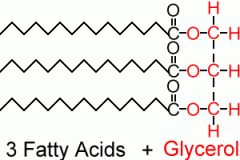
3 fatty acids ester linked to a 3C backbone (glycerol)
-primary biological storage form of lipids (body fat) -less soluble in H2O that fatty acids because they fom ester link between alcohol and carboxylic grp which removes their polarity -less dense than H2O: fats and oils float |
|
|
Strorage Lipids: waxes
|

long chain alcohols ester linked to long chain saturated or unsaturated fatty acids
-insoluble + have high melting points -FXNS: storage, protection, waterproofing, evaporation |
|
|
Biologically active Lipids
|
present in much smaller amounts than storage or structural lipids (usually only appear when needed)
play vital roles as signaling molecules between nearby cells arachnoic acid derivative and lipid soluble vitamins |
|
|
Biologically Active Lipids: Arachnoic Acid Derivatives
|
serve as signaling lipids - enzymatic oxidation of arachnoic acid can yeild:
1. prostogalandin, 5C ring involved in inflammation and fever 2. thromboxanes, 6C ring with ether linkage, formation of blood clots 3. leukotriene, 3 conjugated double bonds, smooth muscle contractions in lungs all paracrine hormones |
|
|
Biologically Active Lipids: Lipid Soluble Vitamins: Vitamin A
|
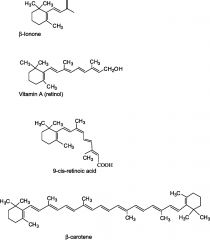
VitaminA: retinoic acid, involved in visual pigment and precursor for other hormones involved in signaling
Bcarotene (carrots) > vitamin A (retinol) > (oxidation of alcohol to aldehyde) > retinal (helps see colors) > (oxidation of aldehyde to acid) > retinoic acid (signal for cell growth and division) and all-trans retinal (signal to brain) |
|
|
Biologically Active Lipids: Lipid Soluble Vitamins: Vitamin D
|
regulates calcium uptake
UV light splits 7-dehydrocholesteral into cholecalcifurol (D3) which isnt a biologically active lipid > further processed in kidnes and liver to become 1a25 D3 (calcitrol) which regulates calcium uptake |
|
|
Biologically Active Lipids: Lipid Soluble Vitamins: Vitamins E and K
|
aromatic ring attached to an isoprenoid side chain (hydrocarbon (fatty acid))
aromatic rings react with and destroy most forms of oxygen radicals |
|
|
Membrane Lipids (Ampiphatic): Sterols Structure
|
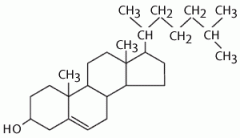
Steroid nucleus - 4 fused rings, planar (very rigid)
Polar head - hydroxyl group (polar head) attached to the A ring Nonpolar side chain - various nonpolar side chains may be attached Ampiphatic molecule |
|
|
Membrane Lipids (Ampiphatic): Sterol function
|
cholesterol and related sterols are in eukaryotic cell membranes (bacteria lack!)
-modulate fluidity/permeability -thicken membrane -mammals obtain cholesterol from food or synthesize it naturally in the liver -cholesterol bound to proteins is transported to tissues via blood vessels - may bind to arteries and clog |
|
|
Membrane Lipids (Ampiphatic): Sterols: Steroid Hormones
|
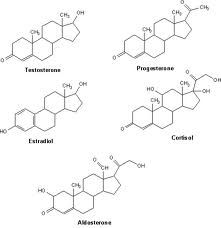
steroids are oxidated derivatives of sterols (less electrons)
- have steroid nucleus but lack the alkyl chain attached to ring 4 - (have some types of alcohols attached to rings) - more polar than cholesterol - synthesized from cholesterol in gonads and adrenal glands - carried through blood stream attached to carrier proteins |
|
|
Structural membrane lipids (polar)
|
- contain polar head groups and nonpolar tails (usually attached fatty acids - important for formation of the membrane)
- diversification can come from modifying the backbone, changing the fatty acid, or modifying the head group (+, -, neutral) - properties of head groups determine the surface properties of membranes - different organiss have different membrane lipid head group compositions - different tissues have different membrane lipid head group compositions |
|
|
Membrane Lipids (polar): Phospholipids: Glycerophospholipids
|
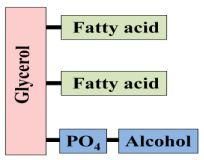
primary constituents of cell membranes
polar head group joined to hydrophobic moiety by a phophodiester linkage - charged at physiological pH |
|
|
Membrane Lipids (polar): Phospholipids: Glycerophospholipids: ester linked
|
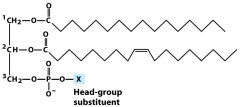
2 fatty acids form ester linkages with the 1st and 2nd hydroxyl groups of glycerol (if unsaturated, will be connected to the 2nd C)
|
|
|
phosphotadylcholine
|

ester linked glycerophospholipid, phophocholine head group
- major component of most eukaryotic membaranes, if moved from the cytoplasm to outer membrane it becomes a marker for apoptosis |
|
|
Membrane Lipids (polar): Phospholipids: Glycerophospholipids: ether linked
|

1 of the 2 acyl chains is attached to glycerol in an ether rather than ester linkage (+ polar head group)
|
|
|
plasmologen
|
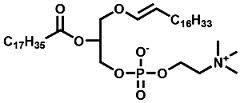
ether linked glycerophospholipid, ethanolamine head group
vinyl ether analog of phosphotadylcholine; important in ehart tissue, function not well understood; |
|
|
platelet activating factor
|

ether linked glycerophospholipid, aliphatic ether analog of phosphotadylcholine
stimulated blood platelet aggregation mediates inflammation acetic acid has esterfied position at C2 (acetyl ester) ether linked alkane choline head group |
|
|
ester linkage
|
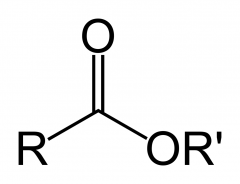
ester; carbonyl adjacent to an ether linkage
-OH group replaced by O(alkyl) group |
|
|
ether linkage
|
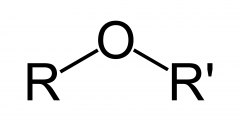
oxygen connected to 2 alkyl groups
|
|
|
alkyl group
|
saturated hydrocarbon
|
|
|
Membrane Lipids (polar): Glycolipids: Glycosphingolipids
|

backbone is sphingosine (long chain amino alcohol)
fatty acid is joined to sphingosine via an amide linkage polar head group is connected to sphingosine via a glycosidic linkage (mono or oligosaccharide) glycosphingolipids are found on the outer face of the plasma membrane - important signaling lipids |
|
|
Glycerosphingolipids and blood type
|
-blood groups determined by the type of sugars on the head groups in glycosphingolipids
- structure is determined by the expression of specific glycotransferases (enzymes that carry the sugar to glycosylate the glycosphingolipid) -ppl without enzyme have type O -ppl with glycosyltransferases that transfer Nacetylgalactosamine group have A blood -ppl with glycosyltransferases that transfer a galactose have B glood |
|
|
Sphingolipids
|

- backbone is a long-chain amino alcohol sphingosine
- fatty acid is joined to sphingosine via an amide linkage rather than an ester linkage - polar head group is connected to sphingosine by a glycosidic or phosphodiester bond |
|
|
amide linkage
|

|
|
|
carbonyl
|
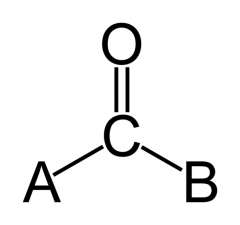
C-O double bond
|
|
|
Membrane Lipids (polar): Phospholipids: Phosphosphingolipids
|
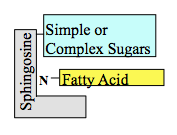
-backbone is a long chain amino alcohol sphingosine
-fatty acid is joined to sphingosine via an amide linkage -polar head group attached to sphingosine via a phosphodiester linkage - most sphingolipids can be derived from ceramide |
|
|
sphingomyelin
|
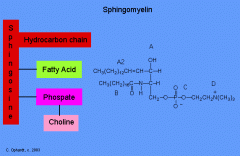
example of phosphosphingolipid
ceramide (sphingosine + amide linked fatty acid) + phosphocholine attached to the alcohol abundant in the myelin sheath surrounding nerve cells structurally similar to phsophatidylcholine |
|
|
SUMMARY: (1) lipids are... (2) triacylglycerols are... (3) phospholipids are... (3) sphingolipids play... (4) cholesteral is.... (5) some lipids....
|
(1) a structurally and functionally diverse class of molecules that are poorly soluble in water
(2) the main storage lipids (3) the main constituents of membranes (4) play roles in cell recognition (5) both a membrane lipid and a precursor for steroid hormones (6) carry signals from cell to cell and from tissue to tissue |

